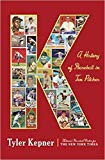Play Ball!

Baseball junkies will love this book. Even casual (October-come-lately) fans will get a buzz off it. And anyone who has swung a bat at a 12-6 curveball as it bounced in front of home plate will appreciate this confirmation that hitting a baseball is the most difficult thing in all of sport.
Tyler Kepner, national baseball writer for The New York Times, clearly loves what used to be America’s pastime, and his affection shines through on every page. He has loved the game since he was a boy and now in his mid-40s he not only writes about it – he still plays it, on fields where rival Fourth-Estate hackers do battle. He is, of course, a pitcher.
K: A History of Baseball in Ten Pitches uses an ingenious microscope through which to scrutinize baseball ("K" is scorekeeping shorthand for a strikeout). The author elevates trivia and manages to make it consequential. For example, in 1920 America went dry, like totally: Prohibition commenced and the spitball pitch was banned. Neither interdict worked.
And not many people know that New York Yankee right-hander Ralph Terry tossed the last pitch of both the 1960 and 1962 World Series. Fewer still know the pitches he threw and the ones he chose not to. Those were two consequential decisions. One of them sent this author’s beloved San Francisco Giants down to defeat.
Looking at baseball pitch by pitch cleverly conjures the wonders of the game and how it has changed. Take the screwball. Hardly anyone does anymore because no one throws it today, but in 1963 Juan Marichal and Warren Spahn, Hall of Fame aficionados of the “scroogie,” leaned on that peculiar pitch throughout their epic 16-inning battle. Willie Mays mercifully ended the stalemate with a home run, the game’s only tally, off of Spahn. He hit a “hanging screwball,” Kepner writes. Live by the sword, die by the sword. Bye the bye, any pitch preceded by the modifier “hanging” is not long for the field of play.
But back to that magical night in San Francisco: Marichal threw 227 pitches. To recap (in case typos are suspected): that was 16 innings and 227 pitches, which translates to roughly three games worth for today’s measly mortals.
Kepner keeps his pitch count to 10, each getting a proper biography, from birth through the vicissitudes of fashion and efficacy. The provenance can be murky. Old timers didn’t always give their pitches names, or the names kept changing. Take the curveball (this author always did): aka the hook, the bender, or, more familiarly, Uncle Charlie. Some say it first appeared during the Civil War. Others say otherwise. Sometimes a curve is not exactly a curve, for example, when it’s a “slurve,” which didn’t make Kepner’s top 10.
And for the longest time people questioned whether a curveball curved at all, or was rather some sort of optical illusion. In the late 1940s, on TV, Burgess Meredith hosted an investigative program that examined whether Preacher Roe’s bender actually bent. The cameras revealed what any Little Leaguer already knew: It most certainly did. The book is full of such delightful tidbits.
In any culture, wisdom (or folly) needs to be passed down from one generation to the next and baseball is no exception. Johnny Podres would deploy his remarkable changeup to close out the 1955 World Series win for the Brooklyn Dodgers. The lefty, who would become a pitching coach, passed along his devastating pitch, thrown with the same arm movement as a fastball but traveling 10 mph slower, to the likes of Frank Viola and Pedro Martinez. The latter used it to help the Boston Red Sox win the 2004 World Series, breaking “The Curse of the Bambino” that dated to 1918.
Kepner’s book, his first, captures both the glory and vagaries of the sport he loves, past and present. What is the best pitch of all? The knuckleball? The splitter? The sinker? The cutter? It’s hard to say. It depends on who’s throwing it, and where, and what other pitches the hapless hitter has to contend with. If a batter is worried about Sandy Koufax’s spectacular hook, good luck catching up with his high hard one.
So how about that old standby, the fastball, aka the hummer, the heater, high cheese, gas, the bullet, etc.? Or, perchance, is it good old Uncle Charlie? Kepner reports that in 2017 Lance McCullers Jr. threw 24 curveballs in a row; he not only lived to tell the tale, he also sent the New York Yankees down to defeat in the American League Championship Series.
No less an authority than Ted Williams voted for the slider. But the author himself avers, using a qualifier, “The best pitch in baseball is a well-located fastball.” Like most baseball arguments, this one thankfully will never end. And, of course, any pitch that hangs need not apply.